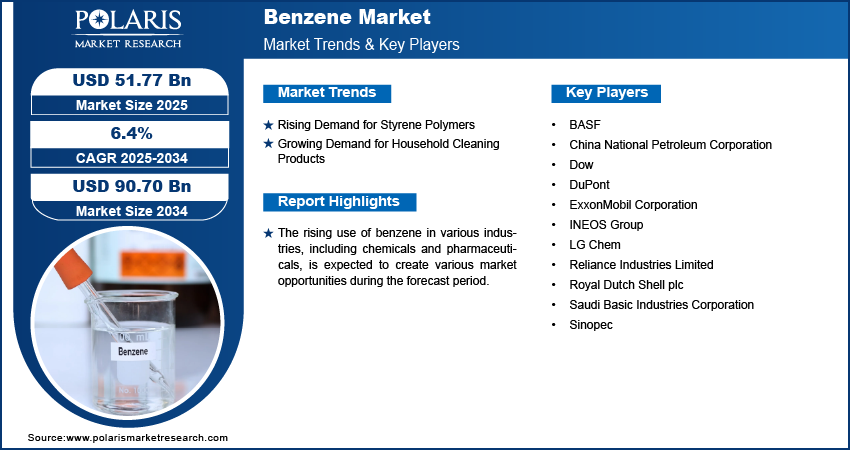Benzene Market Witnesses Steady Growth Amid Rising Demand from Petrochemical and Industrial Sectors

The global benzene market is experiencing consistent growth, driven by increasing demand from a wide range of end-use industries such as chemicals, plastics, automotive, and construction. Benzene serves as a fundamental building block for numerous benzene derivatives, including ethylbenzene, cumene, and cyclohexane, which are essential in the production of plastics, resins, synthetic fibers, and solvents.
The global benzene market size is expected to reach USD 90.70 billion by 2034, according to a new study by Polaris Market Research.
Market Overview
Benzene is an aromatic hydrocarbon widely used as a petrochemical feedstock. It is primarily produced through processes like catalytic reforming and steam cracking. Its chemical stability and versatility make it a core raw material in industrial applications. The global market is witnessing a shift toward advanced manufacturing technologies and improved recovery processes to maximize benzene yield while reducing environmental impact.
Key Market Growth Drivers
-
Expanding Petrochemical Industry:
The growing need for polymers, plastics, and resins in industries such as packaging, electronics, and automotive continues to drive benzene demand. Derivatives like styrene and phenol, used to make polystyrene and polycarbonate, rely heavily on benzene as a feedstock. -
Industrialization in Emerging Markets:
Rapid industrial development in countries like China, India, and Brazil is fueling the demand for benzene in paints, adhesives, insulation materials, and rubber products, which are extensively used in manufacturing and infrastructure projects. -
Growth in Automotive and Construction Sectors:
Benzene-derived materials like nylon, ABS (acrylonitrile butadiene styrene), and synthetic rubber are critical in automotive components and building materials. The resurgence in automotive production and construction activities post-pandemic is contributing to market growth. -
Technological Advancements in Production:
Innovations in catalytic reforming and eco-friendly production processes are enhancing operational efficiency while minimizing emissions, helping meet stringent environmental and safety standards.
Market Challenges
Despite strong demand, the benzene market faces notable challenges:
-
Environmental and Health Regulations:
Benzene is classified as a hazardous chemical due to its toxic and carcinogenic nature. Increasingly strict environmental regulations related to occupational exposure and emissions may hinder its widespread use, especially in developed regions. -
Price Volatility of Raw Materials:
Benzene prices are influenced by crude oil and naphtha markets. Fluctuations in feedstock costs can impact production margins and lead to supply chain uncertainties. -
Availability of Alternatives:
Growing interest in safer and more sustainable alternatives, such as bio-based chemicals, could restrain the long-term growth of the benzene market.
𝐆𝐞𝐭 𝐄𝐱𝐜𝐥𝐮𝐬𝐢𝐯𝐞 𝐒𝐚𝐦𝐩𝐥𝐞 𝐏𝐚𝐠𝐞𝐬 𝐨𝐟 𝐓𝐡𝐢𝐬 𝐑𝐞𝐩𝐨𝐫𝐭: https://www.polarismarketresearch.com/industry-analysis/benzene-market/request-for-sample
Key Companies
Leading players in the benzene market are focusing on capacity expansions, technological advancements, and the development of safer, more sustainable production methods. Key companies include major petrochemical producers and integrated oil & gas firms with global supply chains and diversified chemical portfolios.
- BASF
- Chevron Phillips Chemical Company LLC
- China National Petroleum Corporation
- Dow
- DuPont
- ExxonMobil Corporation
- INEOS Group
- LG Chem
- Reliance Industries Limited
- Royal Dutch Shell plc
- SABIC
- Sinopec
Benzene Market Segmentation
By Derivative Outlook
- Nitrobenzene
- Cyclohexane
- Cumene
- Alkyl Benzene
- Ethyl Benzene
- Others
By End-Use Ourtlok
- Pharmaceuticals
- Agriculture
- Textile
- Automobile
- Paints & Coatings
- Pharmaceutical
- Personal Care
- Others
By Production Process Outlook
- Steam Cracking
- Catalytic Reforming
- Others
Regional Analysis
-
Asia-Pacific:
This region holds the largest benzene market share, with China, India, Japan, and South Korea leading in both consumption and production. The booming petrochemical sector and expanding infrastructure continue to support growth. -
North America:
The market in this region is driven by a strong presence of chemical manufacturers, robust industrial demand, and ongoing technological innovation in production methods. -
Europe:
Growth in Europe is comparatively moderate due to regulatory restrictions on toxic substances. However, the demand for high-performance plastics and composites maintains a steady flow of benzene use. -
Latin America and Middle East & Africa:
These regions are showing gradual growth due to increasing industrialization, urbanization, and investments in manufacturing infrastructure.






